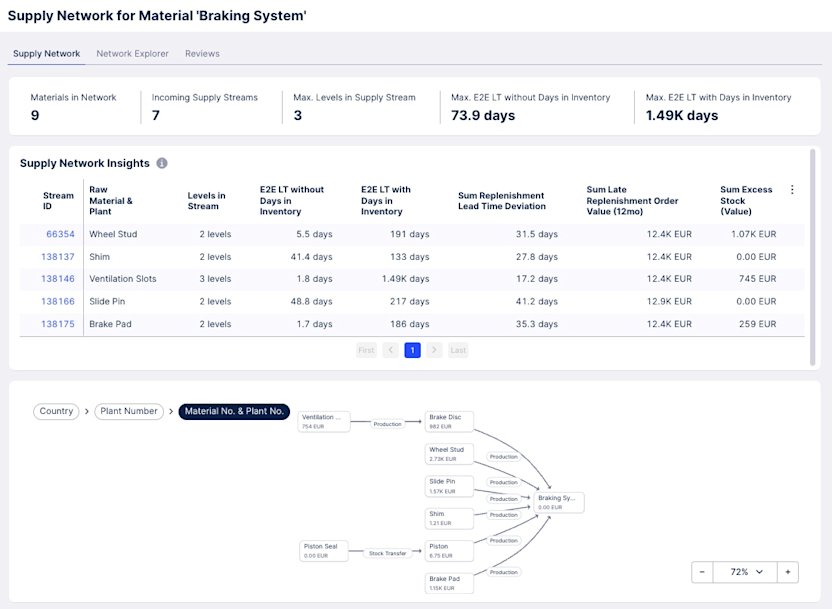
Celonis enables a more agile and resilient supply chain with End-to-End Lead Times App
Supply chain conditions have improved from two years ago, but shifting macroeconomic factors still mean that supply chain shocks happen more frequently and are more severe when they do. Therefore, supply chain managers need ways to make their supply chains more resilient and efficient. Enter Celonis’s End-to-End Lead Times App.
During the kick off stop on the Celonis World Tour 2023, the company unveiled the new Business App along with other product enhancements and offerings. The End-to-End Lead Times App is designed to analyze the entire lead time to procure, manufacture and distribute finished goods. It enables customers to understand how the different processes involved across the supply chain (e.g., procurement, production, order management, etc.) interact with each other to affect the end-to-end lead time and see any bottlenecks that are delaying the entire process.
“Capturing the actual lead time for every finished good globally is challenging, due to the volume of goods that need to be tracked, number of locations the goods can exist in and variations to creating that finished good,” said Peter Budweiser, Supply Chain Product Lead at Celonis, in a press release. “Without the E2E Lead Times App, it wasn’t possible to effectively leverage data to map out every way materials are procured, manufactured, distributed and fulfilled. I am thrilled that now, with this App, we can enable supply chain managers to accelerate their cash conversion cycle while still ensuring they meet service levels.”
Along with the End-to-End Lead Times App, Celonis announced the Multi-Object Process Explorer, an OCPM innovation that allows customers to understand how objects relate to each other and how an event relates to multiple objects involved in a process. Celonis also showed a beta of LLM for PQL Generation, a generative AI tool that translates natural language user queries into Process Query Language (PQL).
The End-to-End Lead Times App is generally available.
What are end-to-end lead times and how do they affect supply chain optimization?
Modern supply chains are incredibly complex. They consist of multiple processes (e.g., sourcing, procurement, production, transportation, warehousing, order management, etc.) that are decoupled from each other (i.e., there is no direct event-to-event or event-object relationship).
Traditionally, inventory is kept at the decoupling points and serves as a buffer between supply and demand variability. For example, manufacturers typically keep a certain amount of raw materials on hand to ensure that a supplier disruption doesn’t stop production. However, supply chain managers can’t sit on too much inventory as this reduces working capital. They also can’t allow the inventory, or safety stock, to fall too low and risk a stock out, which could hurt customer satisfaction.
Supply chain professionals refer to the likelihood of not having a stock-out during a replenishment cycle as the service level. It’s basically the percentage of customer orders that are met by the current inventory or by the current production schedule. In other words, did you plan for the correct inventory to meet the expected demand?
It’s a delicate balance, and supply chain practitioners are always trying to ensure they have the right material on hand at the right time to meet their service levels and minimize excess inventory. To accomplish this, they must understand the the time it takes to acquire the materials needed to create a finished good, the time it takes to get those materials to their plants, the time it takes to produce the finished good and the time it takes to send the finished good to the distribution center so it’s available for customer orders. This timeline is called the end-to-end lead time.
By understanding end-to-end lead times, supply chain managers can:
Find ways to compress lead times to reduce working capital and accelerate cash conversion
Identify ways to exceed service levels by customer
Meet service levels when unexpected disruptions occur
What is the End-to-End Lead Times App?
In addition to their natural complexity, today’s supply chains are further complicated because the individual processes are usually managed by different people, in different departments and using different systems. To effectively analyze and optimize modern supply chains, managers need to see all the paths a finished product can take from creation to delivery and they need technology that goes beyond looking at single cases, like purchase or production orders, but connects multiple objects to shared events.
The Celonis End-to-End Lead Times App leverages object-centric process mining and the company’s Object-Centric Data Model to unite all the objects and processes required to procure, manufacture and distribute the goods into one data model, accelerating the deployment of the solution and making it easier to customize the app to a customer’s supply chain.

The Celonis End-to-End Lead Times App showing the sourcing and distribution network for a finished product
According to the company, the End-to-End Lead Times App allows supply chain leaders to:
Track the movement and location of components through each process required to create a finished good, ensuring they see every path that is required to sell the finished good;
Surface the finished good with the lowest service level or finished good with excess inventory, thereby enabling a focused approach to improving end-to-end lead times;
Identify potential root causes to the end-to-end lead time bottlenecks, like outdated master data resulting in longer lead time calculations - allowing them to take immediate corrective action to improve end-to-end lead times.
Kai Führer, Director Global Supply Chain Controlling at Freudenberg Sealing Technologies, a supplier of advanced materials and products for automotive, industrial and alternate drivetrain applications, said the company reduced working capital across its production sites by “about 10 percent” with the End-to-End Lead Times App.
“Furthermore, with this end to end transparency, we can find ways to deliver the same service in an even shorter time frame and act faster and be more flexible even when disruptions occur,” Führer said. “I’ve worked in Supply Chain for over 20 years. This level of transparency has never been possible. But with Celonis we can stop arguing over the variations and align on a path forward to create a more agile and resilient supply chain.”



